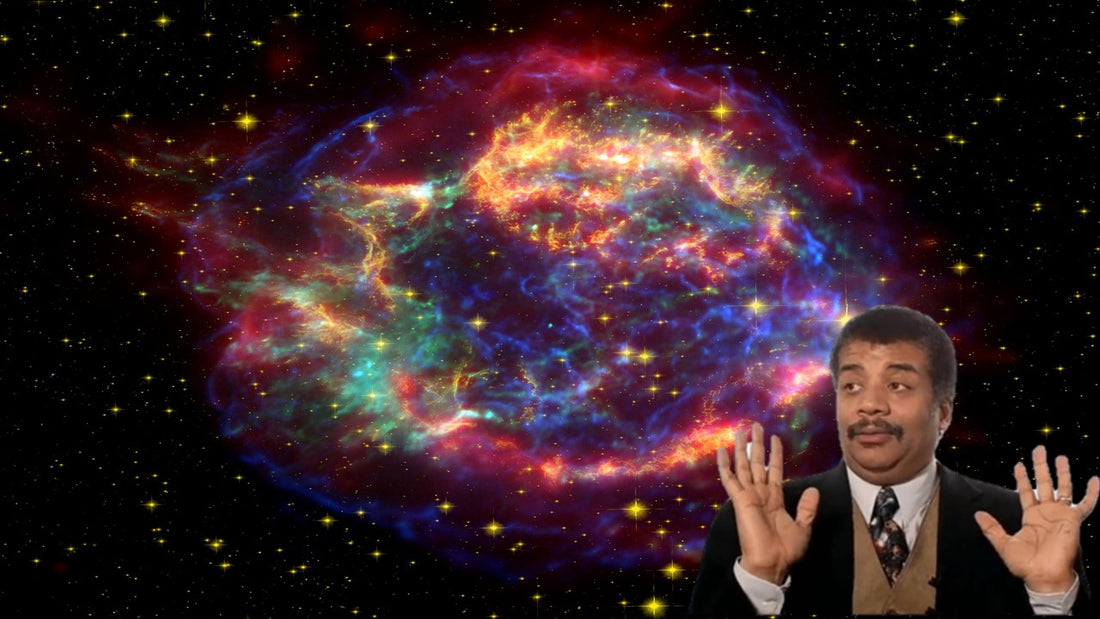
Disembowelled Star Has Skin Unsheathed By Neighbour
Share
Let's get one thing straight: stars aren't cutesy stuff for kids. They might be in lullabies and plastered all over the walls of toddlers, but given half the chance, stars would kill you and everyone you care for.
For instance, a giant star recently kicked the bucket. But it didn't go peacefully into the long night.
No.
It violently erupted its innards into space.
But before this gut eruption took place, its neighbouring twinkle- twinkle stole its skin like Leatherface to some poor college kid.
Thankfully, the culprit to this heinous crime has been fingered.
But here's the twist...
It was another belly-busting star adjacent to the victim.
Dun-dun-dun!!
We think of supernovas as... well... super.
But that's more about their size and not about how rare they are.
In space, supernovas are pretty commonplace.
And the way they die is way more super.
They kick-the-bucket in what is called "stellar explosions". Or, to the regular joe/lene; they die in a moist cloud of fart that spread throughout space.
These star farts are chock full of heavy atoms that live in star bellies.
The bellies of living stars violently churn hydrogen atoms with nuclear fusion create helium which makes the star begin life from a fart in the first place.
The hydrogen (the precursor to helium which ignites stars) lives in the outer layer (or skin) of existing stars where conditions such as temperature and pressure are much lower. As a result, the hydrogen never becomes helium because of the fusion taking place in the belly.
Think of all the unused hydrogen in the star's skin as a potential fuel source, like fat reserves under our skin.
But every now and then, a crime takes place...
And nonconsensual interstellar liposuction happens.What happens?
A neighbouring star's gravity will suck off the fat with its considerable gravity. The hydrogen reserves under the skin are stripped away and consumed by the felonious star.

Such is the story for Cassiopeia A (Cas A).
In a new paper from the ARC Center of Excellence for Gravitational Wave Discovery (OzGrav) in Melbourne, Australia, the team theorised and simulated how the above scenario would - and did - happen.
The crime scene involved twin stars in a tight binary orbit. What is most important is that both stars were born almost simultaneously. They were also near the same size and location. Because of these constraints, the stars would also live for roughly the same amount of time and grow into swollen red giants before they both die of old age. Most likely, close to the same time as similar star mass means the same amount of fuel.
But did this happen?
Nope.

The Aussie team theorised that if Cas A's twin died first, the effects would strip away the remaining 50% and 90% of the surviving star's (Cas A) outer skin of hydrogen.
Lead study author Ryosuke Hirai, an OzGrav astrophysicist, stated: "This is enough for the second supernova of the binary system to become a stripped-envelope supernova, confirming that our proposed scenario is plausible,"
It's also a possibility that the culprit star stole some of Cas A's supple skin causing it to aggressively unsheath. Then it does what anyone would do after having their precious skin and fat sucked off. And that's become unstable and gratuitously explode in a supernova.
How often does this crime happen?
The team estimate less than 1% of all supernovas.
And while it hasn't been confirmed, there are two other scenarios with the same crime occurring in supernovas RX J1713.7-3946 and G11.2-0.3.But for now, Cas A is the most promising event. Why?
Evidence of the crime.
The "smoking gun" in this case was the remnants of Cas A's skin, a space fart travelling away from the scene.
And they found it, 50 lightyears away and fitting their simulation perfectly.
#Space_Aus
Love ARSE and want it painted all over your front?
Grab some gear to show you support for Aussie space!





